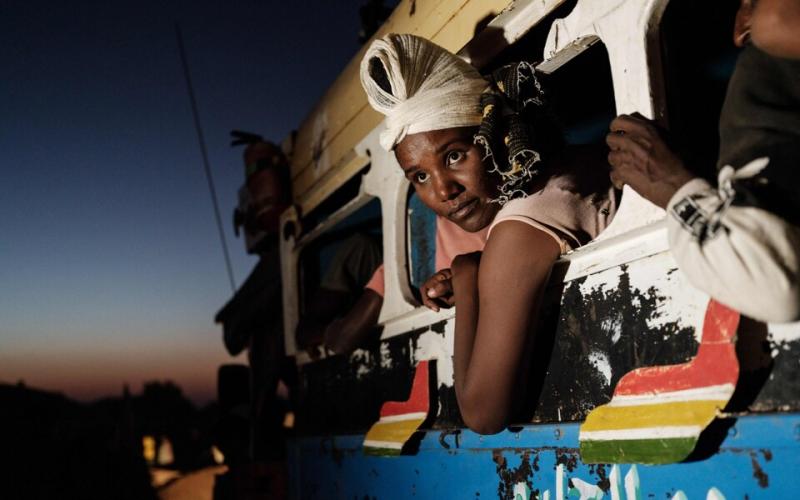
The extent of Eritrea's involvement in Ethiopia's brutal civil war has been exposed after an Ethiopian general was caught on camera admitting soldiers from the secretive gulag-state had been conscripted to fight in his country.
On Wednesday, a video was released on social media showing Major General Belay Seyoum, the head of the Ethiopian army's northern division, admitting that "a foreign force entered the country" and that Eritrean troops had assisted them.
The video comes two months after Ethiopia's Nobel Peace Prize-winning Prime Minister Abiy Ahmed launched a devastating military assault on the northern Tigray province in an attempt to oust the powerful regional government there.
Ethiopia and Eritrea have consistently denied reports that Eritrean troops had crossed the border to help Mr Abiy crush the Tigrayan People's Liberation Front (TPLF).
When confronted by UN Secretary-General Antonio Guterres in early December, Mr Abiy "guaranteed" that there were no Eritrean soldiers in Tigray.
Reacting to a report suggesting that Eritrean soldiers had been deployed to three Ethiopian towns by mid-November, Ethiopia’s ambassador to the US, Fitsum Arega, said: “Repeat a lie long enough, and it becomes the truth.”
But the new video corroborates extensive Telegraph reporting over the last two months which all points towards an Eritrean shadow war in Tigray and egregious abuses, including massacres and pillaging.
One witness said that Eritrean soldiers carried out a massacre of "dozens" of civilians in the town of Idaga Hamus, about 35 km south of the border, shortly after captured on November 21st.
"A lot of Eritrean soldiers died in that battle," Beyene* claimed. "So they took revenge on the town's civilian population, shooting at everyone they encountered and even killing a priest."
Another witness said he saw summary executions of civilians after Eritrea soldiers captured the city of Adigrat, about 85km north of the Tigrayan capital Mekele.
"After Adigrat was captured, Eritrean soldiers gathered a group of young males in civilian attire and accused them of being TPLF fighters," says Kiros.*
"They were taken towards the outskirts of the city, towards the road leading to Adwa (a city some 60km east of Adigrat). At least twelve of them were shot dead. I personally saw the bodies of other people in the city who had been killed by the same soldiers."
The accounts come after the Telegraph published refugees' testimonies of indiscriminate artillery fire raining down on the town of Humera from Eritrea's border a few miles away.
"I saw one lady. She was lying on the ground. She was dead," a refugee called Yared said, describing how the woman's two children lay beside her body on the outskirts of Humera.
"One was about seven years old, but he was also dead. They were killed by a bomb. The other one was a baby. He was trying to breastfeed from her."
The militarised, totalitarian state of about 6m on Ethiopia's northern border has been on a war footing since the country won its independence from Ethiopia in 1993.
Hundreds of thousands of Eritreans have fled the country's horrendous military conscription, which often keeps people working in forced labour for decades.
About 100,000 Eritrean refugees were in Tigray at the onset of the war, many of them draft dodgers.
There are widespread reports of Eritrean soldiers raiding these camps, torturing refugees and deporting them back to Eritrea.
The general’s comments have since been echoed by the Mekele's interim mayor Ataklti Haileselassie.
Appointed shortly after the Ethiopian army’s capture of the Tigrayan regional capital, Mr Ataklti also publicly acknowledged Eritrean troops’ presence on Ethiopian soil.
“But we have been reassured that [the federal government] was working to have them withdraw in the near future,” Mr Ataklti said at a televised community gathering in Mekele which took place shortly after the General’s address.
Eritrea's dictator Isaias Afewerki has long had a vested interest in seeing the TPLF ousted.
Before Mr Abiy was appointed as Ethiopia's prime minister in 2018, TPLF officials dominated the government.
Ethiopian refugees who fled the Ethiopia's Tigray conflict CREDIT: YASUYOSHI CHIBA/AFP via Getty Images
In 1998, Eritrea fell out with the then TPLF-led government over disputed territory on Eritrea and Tigray's border.
isha warka :telegraph.co.uk
A horrific war was waged between the two countries until 2000, killing an estimated 70,000.
Although the military conflict ended in 2000, both states spent the next two decades on a war footing, with troops massed on the border and funding proxy elements to destabilise the other.
Since 2000, the TPLF-led Ethiopian government largely succeeded in getting much of the world to establish warm diplomatic ties with Addis Ababa and isolating Eritrea internationally as a pariah state.
Eritrea was left with little leverage or diplomatic clout when it was slapped with sanctions and an arms embargo by the UN in 2009, for allegedly supporting extremist groups in Somalia.
Mr Isaias spent years lashing out at Addis Ababa and the TPLF, who he blamed for Eritrea's isolation.
In 2018, Mr Abiy extended an olive branch in 2018, restoring ties with Eritrea. The endeavour would win him the Nobel Peace Prize in 2019 and help bring the Eritrean dictator in from the cold.
But analysts now think that this prize-winning peace deal was little more than a military pact designed to crush the TPLF once and for all.




